This is not a history of the BBC Lime Grove Studios – for the history of Lime Grove, please see the history of the TV studios in London: http://www.tvstudiohistory.co.uk/.
Dave Newbitt
With the recent forum focus on Television Centre, in particular the wonderful cutaway drawings, my thoughts went back to the earlier wonder of Lime Grove. I honestly can’t recall whether I’ve posted this before (or indeed if it’s known about because someone else posted it), but this pre BBC occupation cutaway is a fascinating reminder even if hardly in the same class as the TC one.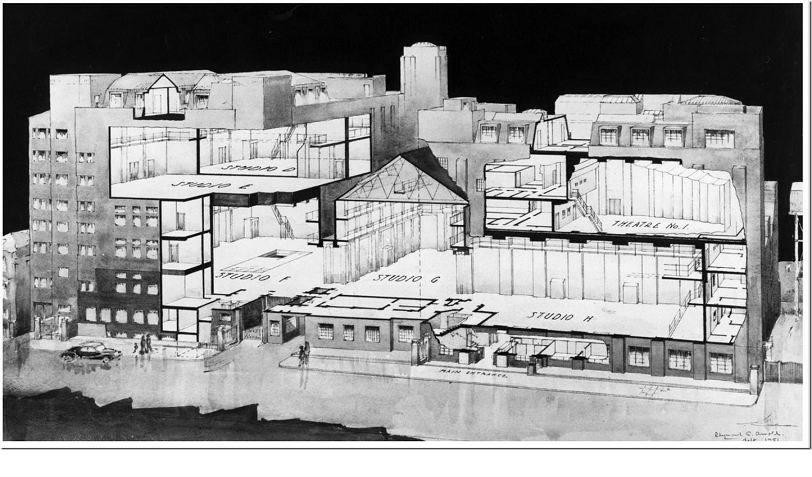
Pat Heigham
Wikipedia is not always 100% correct – it mentions “Steptoe & Son” being made in Lime Grove, but as it was an audience show, when I was Grams on it, I always knew it as being from TC3 or 4 which had the audience seating.The diagram must have been drawn in TV days, as in the film industry, the ‘studios’ are known as ‘stages’ – a throwback to theatre?
Also mentioning “The Grove Family” – I refused a second half in the Club at suppertime, and got to the studio for “The Grove Family”, (live), climbed up on the boom – I had the first line of dialogue – just as the Transmission countdown had reached ‘five’. Sound Supervisor was having kittens, as he couldn’t raise me on talkback! Phew! That was close!
If I had wished to buy a flat on the site, after demolition, I might have named it Studio R, after the sound studio wherein I spent most of my Wednesdays for several years, assembling the effects for “Dr. Who”. Wikipedia: Lime Grove Studios
Graeme Wall
Didn’t D have audience seating?David Brunt
Seems that the BBC bought Lime Grove in November 1949, the drawing is dated 1951.Hancock had an audience in D in the 1950s. Studio G would also have had seats for the Simon Dee audiences.
Albert Barber
This Alamy copyright photo is described as the first production by the BBC at LG Studios. Dated as being May 1950, Studio D with Wilfred Pickles seated. And doubtless with “Mabel at the table” somewhere!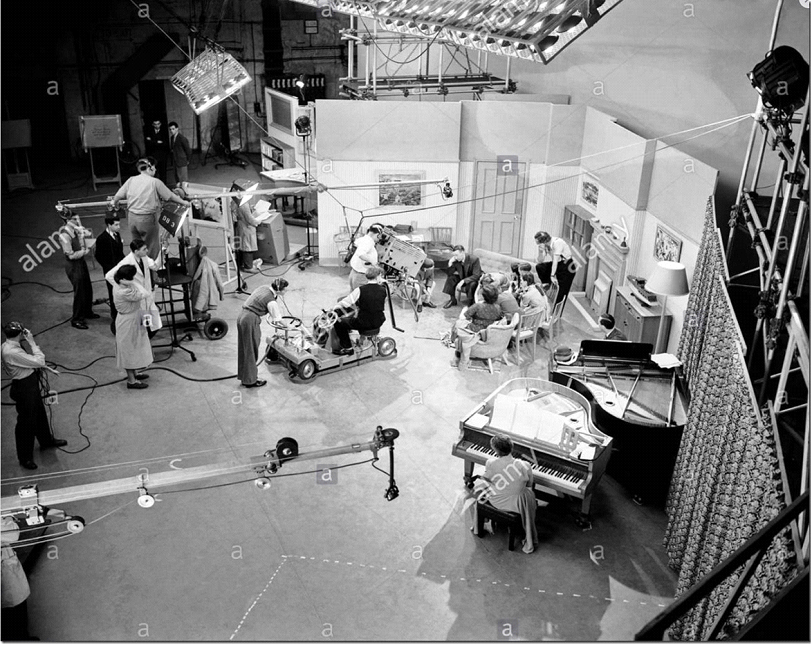
Dave Newbitt
The Wiki item Pat draws attention to gives 21st May 1950 as the BBC opening of the LG Studios. That would tie in with the claim on the Alamy photograph. I’ve posted that May 1950 saw the first of the productions from the complex, specifically from Studio D.As to the date for the drawing, it is in a way academic as it represents the layout as it stood at the start of the BBC era. I don’t remember where I found the image but it was around 5 years ago and although dated 1951 I had made a note at the time that the drawing had been executed in 1950. If that was the case then the fact of a first production in May of that year would not preclude the possibility of the drawing predating the official opening.
Pat’s point about studios/stages is well made but if the drawing was executed/commissioned looking ahead to the upcoming opening, the terminology employed would have anticipated that.
Pat Heigham
I can enlarge on the colour shot taken in the Sound Control of ‘D’ in >Old BBC Studios: LG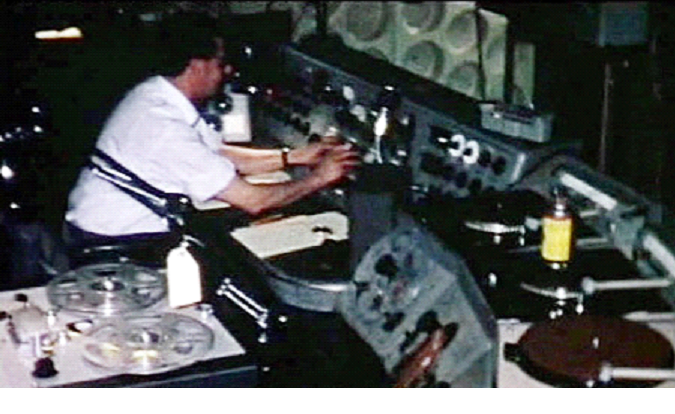
I gave permission for 2-Entertain, who produce the commercial DVDs of some BBC programmes, to use it, and it appeared on the extras disc of “Dr. Who – The Ice Warriors”. I also took part in a commentary recording, also contained on the extras DVD.
Here’s a photo of that session:
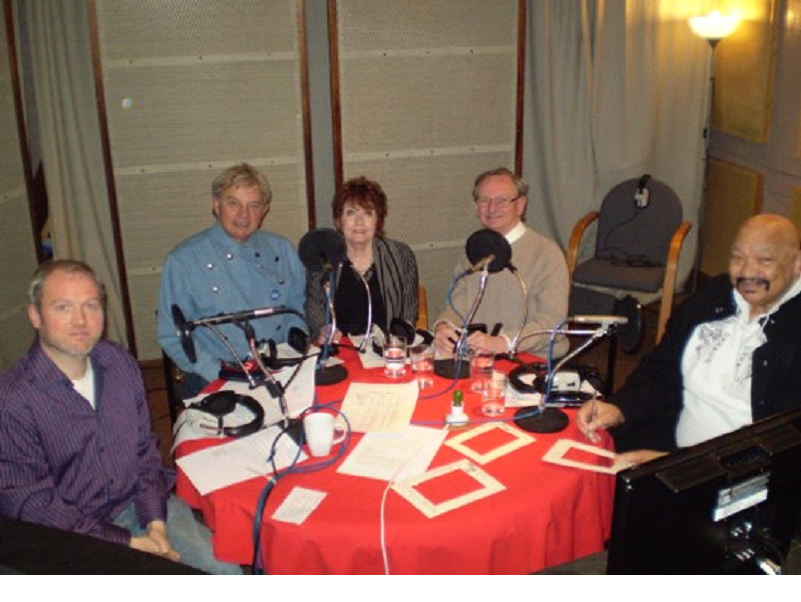
It was recorded at Paddy Kingsland’s Hammersmith studio, he was instrumental in the Radiophonics Workshop at Maida Vale, previously.
Toby wanted to do a follow-up podcast about sound and grams work, so I roped in Mike McCarthy, in whose dining room we recorded. It was an excellent session, as we kept bouncing memories off each other.
Mike Giles
Yes, Jack Brummitt went to Bristol where he became an SA1, rather than SS.I have forgotten the story behind the move, but he was a great teacher and I learnt a lot from him. I recall that he’d had an argument with a telegraph pole, whilst riding a motorbike, I fancy, and he proudly wore the yellow pullover that still showed the resulting black pitch stains. I think he’d probably been quite badly hurt, but he still wielded an impressive boom.
He was doing a boom for “Going for a Song”, with Arthur Negus, with Dickie Bird on the other boom, I believe, later one of David Attenborough’s regular recordists. They misjudged the time and were still in the bar when someone rang the barman to ask if they were there as we were within ten minutes of transmission! They raced back and were horrified to see that the two- minute red lights were already flashing as they came down the corridor. The small audience was amazed to see these two rush to their booms and leap onto the platform just as the opening titles were running. Fortunately their athleticism was equal to the task and there were no mishaps as they climbed the precarious steps of the Mole boom. No questions were asked afterwards as far as I can recall and the show went without a hitch.
I can’t put a date on it, but Jack died some time ago.
Pat Heigham
I very much liked working with Jack, a very pleasant man. Mostly with him on “Dr. Who” – the early days! I think I knew he had passed away – and I was saddened to hear.The story of the two boom ops nearly missing transmission so closely matches mine on “The Grove Family”, so maybe it’s something in the beer!
Martin Ridout
Some years ago I found a book in a charity shop about the Lime Grove studios pre-BBC. It was published in the early to mid 1930s by Gaumont-British Picture Corporation.I have been meaning to digitise it and share it here. This thread was the trigger to do so. So here it is as a pdf file: Gaumont-British Picture Corp at Lime Grove. Many interesting pictures of the studios and support areas, and plans of the three floors. (As far as I know, there are no copyright issues.)
First Floor plan:
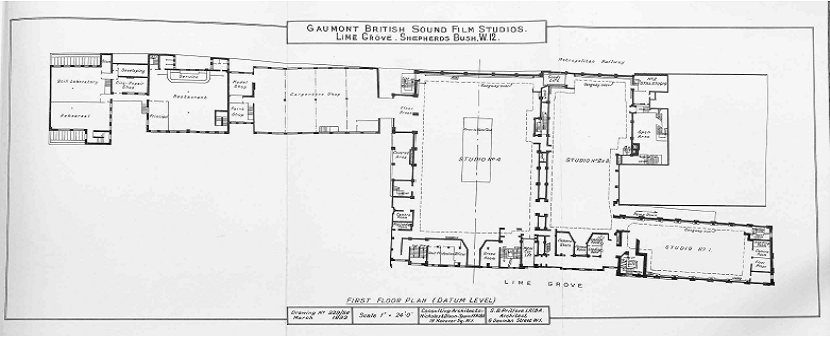
Dave Newbitt
What a treasure house of information Martin, fascinating on every level. Thanks are due to you for making it available to us all . Well done indeed!Can’t resist noting that the authors are quite happy with ‘studio’!



